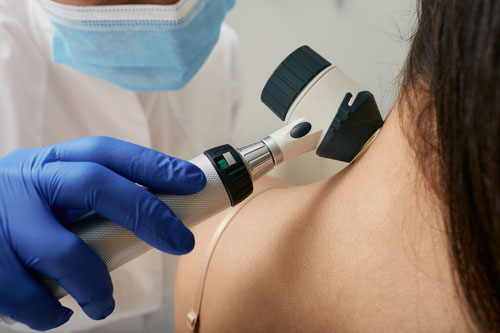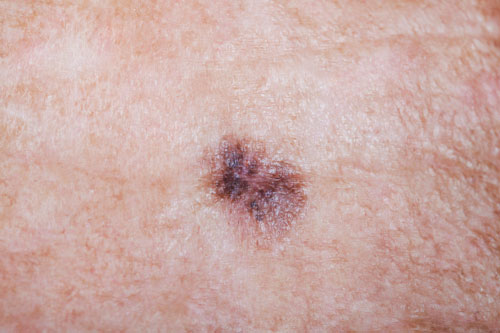Melissa Kultgen was four months pregnant with her first child when she noticed that the small black mark on the right side of her upper lip seemed to be getting bigger. “When I first discovered it two years earlier, I thought nothing of it,” she says. “I have a lot of freckles and moles, and it was tiny, the size of a dull pencil tip.”
“It was so painful; I was afraid to even touch my mouth. I had to use a straw to consume food.”
But a few months into her pregnancy, that minuscule black mark started growing bigger and wider, becoming more of a raised lump than a freckle. Eventually, the lesion began to crack and bleed. Concerned, Kultgen made an appointment with her primary care doctor. “It’s fine,” he told her, explaining that her elevated level of hormones was probably causing it to get bigger, and she shouldn’t worry about it. Not worrying about the large, black, evolving mass on her lip became increasingly difficult as it grew so big it began to hang over her lip, making it challenging for Kultgen to eat. “I couldn’t even use a spoon because it was constantly cracking and bleeding,” she recalls. “It was so painful; I was afraid to even touch my mouth. I had to use a straw to consume food.”
She returned to her primary care, who — at her insistence — finally referred her to a cosmetic surgeon. He, too, assured her that it was nothing to be concerned about. “We’ll take it off after the baby is born,” she recalls him telling her. Eventually, however, the lump grew so big and painful, Kultgen couldn’t wait any longer. So her doctor scheduled her for surgery. But her baby had other plans, arriving two weeks early, delaying her procedure by another few more weeks.
“It’s crazy,” she says now. “I have these pictures of me holding my newborn baby, and you can see this massive black lump on my lip. Looking back, I’m like, ‘Oh my god!’” When Kultgen finally had the surgery about a month later, her doctor continued to assure her not to worry. “He told me he was going to send it out for a biopsy ‘just for fun.’”
She returned to his office a week later for a follow-up. “He told me the scarring was looking good,” Kultgen recalls. “Then he looked me straight in the eye and said, ‘I’m sorry, hon, but you have cancer.’” Kultgen looked down at her three-week-old daughter, who was sleeping quietly in a car seat by her feet. “My whole world just stopped,” she says. “I was shattered.”
Kultgen was just 27 years old when she was diagnosed with stage II malignant melanoma, the most dangerous form of skin cancer. While skin cancer is common and usually survivable, melanoma, which is far rarer (representing just 1% of all skin cancer diagnoses), accounts for most deaths, according to the Skin Cancer Foundation.
Since melanoma, a.k.a. “the black tumor,” is a fast-moving and virulent cancer, early detection is critical. While the five-year survival rate for Stage 1 melanoma (localized, less than one millimeter thick) is 99%, the survival rate plummets to 68% if the disease reaches the lymph nodes (regional) and 30% if it spreads to other organs (distant), reports the American Cancer Society.
Thankfully, even though Kultgen’s melanoma grew — undetected but in plain sight — for many months, it was removed before it spread to the lymph nodes. Though Kultgen’s case was atypical (only 1-2% of all melanomas occur in the oral area, according to the National Institute of Health), it demonstrates how easy it is for melanoma to be missed or mistaken for something else, even by primary care doctors.
Her story is a cautionary tale illustrating the importance of regular full-body skin cancer checks, which should be conducted yearly (or more often if you are at high risk). And if you see something suspicious, don’t rely on your primary care doctor, as Kultgen did. Instead, make sure you see a board-certified dermatologist, ideally one who specializes in identifying skin cancer.
Kultgen’s body is covered with moles, but the one that started growing on her lip is a textbook example of what skin cancer experts call “the ugly duckling.” Since most moles on one’s body tend to resemble each other, if one of them stands out like an “ugly duckling,” dermatologists say it should set off alarms.
Meet the Experts
Michele Greene is an N.Y.C.-based dermatologist.
The ABCDEs of Melanoma
Melanomas are most likely to appear on women’s legs (for men, it’s the trunk). But, of course, as Kultgen’s case makes clear, melanomas can appear anywhere on the body, and those are often the ones that are the most easily overlooked.
For example, melanoma is far rarer among African Americans (representing only around 1% of all cases). When it does appear, it often presents in odd places that aren’t even exposed to sunlight (for example, under a fingernail or toenail, where it manifests as a dark brown or black vertical line, or on the palm, bottom of the foot, or under or around the nail).
Dermatologists at NYU Langone Medical Center created the following checklist to help people learn how to identify suspicious growths:

- Asymmetry: While most moles are symmetrical—meaning one side matches the other—melanomas tend to have a wonky shape. They aren’t usually perfectly round or uniformly oval; instead, they have more of a blotchy shape. According to the AAD, melanomas can sometimes look like a slow-growing skin patch resembling a scar.
- Border: While typical moles tend to have smooth, even edges, melanoma is more jagged and uneven.
- Color: While regular moles are usually one shade of brown, melanomas often have multiple shades of brown, tan, or black. And as they grow, stranger colors—like red, white, or blue—may even appear.
- Diameter or Dark: If a lesion is as big as a pencil eraser (or larger), it should set off alarm bells. But since early detection is critical, many dermatologists say it is important to look at any very dark lesion—no matter how small. “I’ve removed many melanomas that were tiny,” says N.Y.C. dermatologist Michele Greene when I told her that Kultgen’s melanoma was no bigger than a dull pencil tip when it first appeared. “If you wait until a dark mole grows to the size of a pencil eraser, it may be too late, and the cancer could have already spread.” Keep in mind: While most melanomas are dark brown or black, they can also be pink, tan, or red (resembling a sore or cyst). There is even a very rare kind called amelanotic melanoma, which is colorless.
- Evolving: If any spot on your body starts to change in size, shape, color, or elevation, get it checked by a derm. Also, remember how Kultgen’s mole started to crust and bleed? That — along with itching — can also indicate a lesion is malignant.
We only recommend products we have independently researched, tested, and loved. If you purchase a product found through our links, Sunday Edit may earn an affiliate commission.







